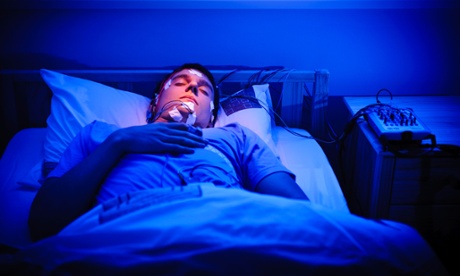
Damage to certain parts of the brain can lead to a bizarre syndrome called hemispatial neglect, in which one loses awareness of one side of their body and the space around it. In extreme cases, a patient with hemispatial neglect might eat food from only one side of their plate, dress on only one side of their body, or shave or apply make-up to half of their face, apparently because they cannot pay attention to anything on that the other side.
Research published last week now suggests that something like this happens to all of us when we drift off to sleep each night. The work could help researchers to understand the causes of hemispatial neglect, and why it affects one side far more often than the other. It also begins to reveal the profound changes in conscious experience that take place while we fall asleep, and the brain changes that accompany them.
Hemispatial neglect is a debilitating condition that occurs often in people who suffer a stroke, where damage to the left hemisphere of the brain results in neglect of the right half of space, and vice versa. It can occur as a result of damage to certain parts of the frontal lobes, which are involved in alertness and attention, and the parietal lobes, which process information about the body and its surrounding space.
In clinical tests, patients with hemispatial neglect are typically unaware of all kinds of stimuli in one half of space – they fail to acknowledge objects placed in the affected half of their visual field, for example and cannot state the location of touch sensations on the affected side of their body. Some may stop using the limbs on the affected side, or even deny that the limbs belong to them. Patients with neglect can usually see perfectly well, but information from the affected side just does not reach their conscious awareness.
In 2005, researchers at the MRC Cognition and Brain Sciences Unit in Cambridge reported that reduced alertness dramatically alters spatial awareness in healthy people by shifting attention to the right so that they neglect visual stimuli to the left. To investigate further, they recruited 26 more healthy participants and tested their spatial awareness while they fell asleep.
To do so, they took the participants one by one into a dark room and told them to sit back in a comfortable reclining chair and relax. They recorded the participants’ brain wave patterns using electrodes attached to the scalp, and measured their reaction times, to determine exactly when they started getting drowsy, then played sounds to either their left or right, and asked them to indicate which side each one came from by pressing one of two buttons.
Again, the researchers saw that reduced alertness caused a rightward shift in spatial attention. During the few moments of drowsiness just before falling asleep, the participants consistently mislocated sounds played to their left, and said that they had been played to the right.
“This is an exciting development,” says Masud Husain, a clinical neurologist at the University of Oxford who studies neglect in stroke patients. “It suggests that while falling asleep the healthy brain behaves in a similar way to stroke patients who have difficulty keeping alert.”
The findings further suggest that the attentional deficits associated with hemispatial neglect apply to sounds as well as to sights and bodily sensations, and also provide clues about why, in the vast majority of cases, neglect only persists after damage to the right hemisphere of the brain. “Both groups appear to have particular difficulty attending to information to their left, consistent with the view that frontal and parietal regions of the right hemisphere play a key role in maintaining alertness.”
The study also provides clues about the brain mechanisms underlying neglect. “People don't necessarily miss items on the left as they become more drowsy, but instead respond as if they had come from the right,” says Husain, “as if their perception of space becomes skewed to the right as their alertness declines.”
“The implication is that right hemisphere brain mechanisms that are crucial to representing space around our bodies also interact with processes that keep us vigilant and alert,” he adds. “The results are intriguing but need to be confirmed, perhaps with a more precise method than pressing buttons.”
Reference: Bareham, C. A., et al. (2014). Losing the left side of the world: Rightward shift in human spatial attention with sleep onset. Scientific Reports 4, doi: 10.1038/srep05092

